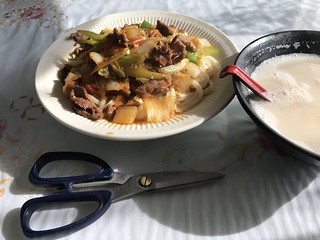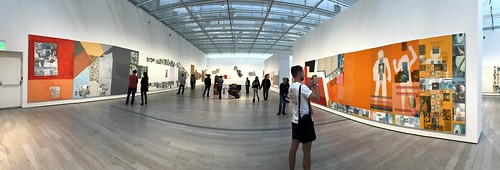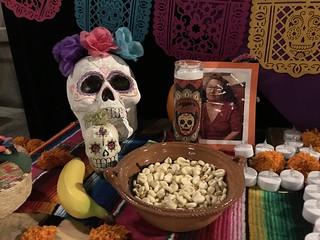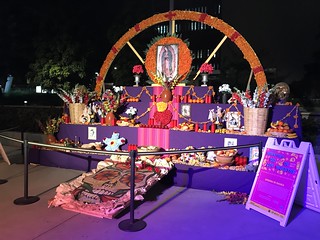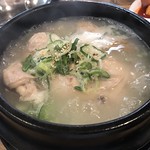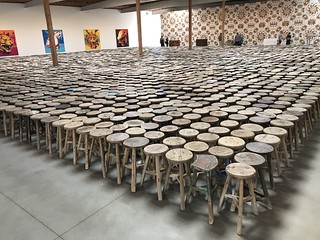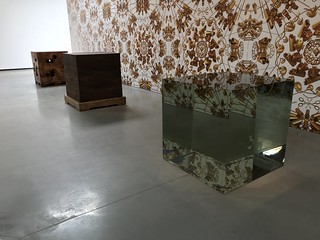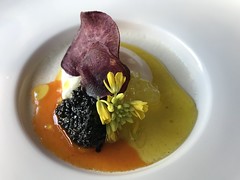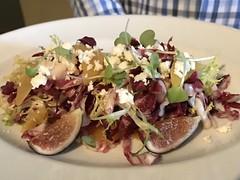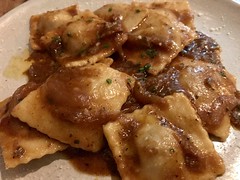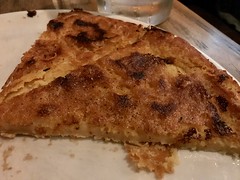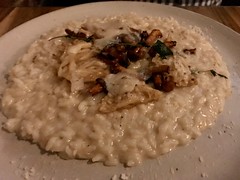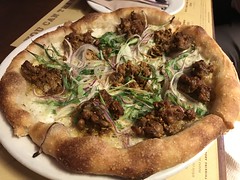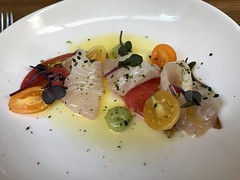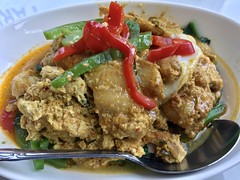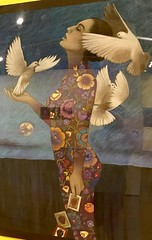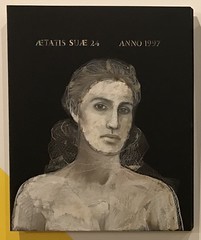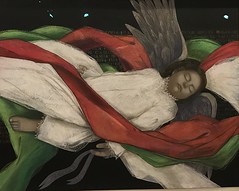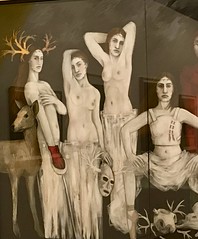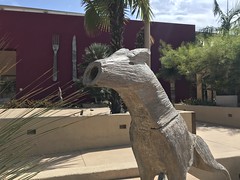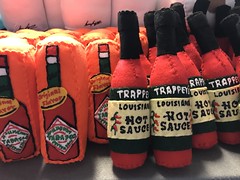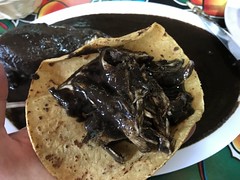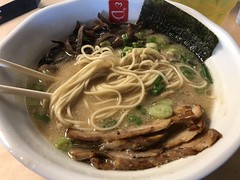Xinjiang, which literally means “new frontier”, is an autonomous province in the far northwest of China, along the Silk Road, the center of waves of cross-cultural pollination from Persia, Mongolia, Turkic tribes, and the neighboring ‘Stans. One of the main ethnic groups there are the Uyghurs, an Islamic people. This being LA, its own cultural cross-roads, of course there’s a restaurant for Halal Uyghur food. And of course I heard about it on KCRW's Good Food show. So I went to check it out. Delicious! I went for the “lag man”, thick hand-rolled noodles served in a hot broth with celery, peppers, and slices of lamb redolent with cumin and chili (modest heat but not tongue-scorching). The noodles are soft and chewy, thick enough that the bowl comes with shears to tame them. For traditional beverage, I took the milk tea, which comes served in a bowl with ladle-like spoon. It was like a really good chai, but with a distinctive hit of salt. A unique blend of broth and tea. For dessert, there’s a house made yogurt which was lovely, naturally sweet from the milk and without a strong fermentation tartness. I want to come back and try more! As an added bonus, while I was eating, who else came in but Evan Kleiman with her KCRW show team including Nick Liao and Abbie Fentress Swanson who produced the Uyghur segment. I was a bit starstruck, but said a quick hello and thanks - so cool to meet them!
Thursday, December 27, 2018
Sunday, December 16, 2018
ART: Rauschenberg's 1/4 Mile
A visiting friend provided a great excuse to check out Robert Rauschenberg's "The 1/4 Mile or 2 Furlongs" at LACMA. Rauschenberg was a renowned late 20th century American artist whose work was exemplified by assemblage of photographs, printed matter, and found objects, combined with overpainting. "The 1/4 Mile or 2 Furlongs" is a single work comprising 190 panels, plus some sculptural objects and some audio tracks, which if laid out linearly would actually be almost 1/4 mile long. The work grew over the course of 17 years (1981-1998) and is kind of a self-contained retrospective of the artist's career, with references to many of his other major works and showing an evolution of styles and phases, a creative array of visual stimulation running the gamut from murky to boldly colorful, and from purely abstract geometrics to human and natural forms. It was intriguing to contemplate the variety of colors and forms in the various panels and other bits and pieces, and also intriguing to think of it as one huge work rather than 200 individual works, and just how that makes you view it differently. I found myself thinking more about order, relationship, and juxtaposition as we wandered through it.
Saturday, November 24, 2018
FILM: The Favourite
 What a sassy, saucy period drama about two clever strong-willed women who contested the position of the Queen’s favorite. While men may have thought they were pushing the women around, it was these women who ruled England. Creatively based on a real historical rivalry, The Favourite provides intrigue worthy of Game of Thrones (and protagonists every bit as formidable as Daenerys and Cirsei), but also tempered with a wry sense of humor at times. Rachel Weisz and Emma Stone are both breathtaking in their performances of these incisively-written characters, complimented by Olivia Colman’s fragile, mercurial Queen Anne. The visuals are lush of the Jacobean opulence, while reminding you that even the most powerful were never too far from the mud, and the sanitation and medicine were more medieval than modern. The direction, along with an intense soundtrack (sometimes more sounds than music), was impressive and made for some memorable scenes. The rivals’ conversations over pigeon-shooting had subtext you could cut with a knife, and the scene of Emma Stone’s honeymoon night is startingly funny. The ending was unexpected (compounded by my knowing just enough of the actual history to be confused), but the sort that forces you to go back and rethink what you thought about all of the characters. As in Game of Thrones, there is unexpected nuance to all of them, and even those who may seem black-or-white are grayer than you first think.
What a sassy, saucy period drama about two clever strong-willed women who contested the position of the Queen’s favorite. While men may have thought they were pushing the women around, it was these women who ruled England. Creatively based on a real historical rivalry, The Favourite provides intrigue worthy of Game of Thrones (and protagonists every bit as formidable as Daenerys and Cirsei), but also tempered with a wry sense of humor at times. Rachel Weisz and Emma Stone are both breathtaking in their performances of these incisively-written characters, complimented by Olivia Colman’s fragile, mercurial Queen Anne. The visuals are lush of the Jacobean opulence, while reminding you that even the most powerful were never too far from the mud, and the sanitation and medicine were more medieval than modern. The direction, along with an intense soundtrack (sometimes more sounds than music), was impressive and made for some memorable scenes. The rivals’ conversations over pigeon-shooting had subtext you could cut with a knife, and the scene of Emma Stone’s honeymoon night is startingly funny. The ending was unexpected (compounded by my knowing just enough of the actual history to be confused), but the sort that forces you to go back and rethink what you thought about all of the characters. As in Game of Thrones, there is unexpected nuance to all of them, and even those who may seem black-or-white are grayer than you first think.
Monday, November 12, 2018
BOOKS: Letter To My Palestinian Neighbor
Yossi Klein Halevi’s “Letters To My Palestinian Neighbor” is an extremely thoughtful and personal plea for dialogue from an Israeli Jew wanting to reach out to his Palestinian neighbors. Halevi lives on a hill in Jerusalem with a view from his apartment to another hill across the way where Palestinians live, a very short distance away as the land lies, yet vastly separated by politics, not to mention a physical wall. He imagines a neighbor on that other hill, and what he would like to tell him about his own life and beliefs. Halevi is a religious Jew and devoted to Israel, but also very open-hearted towards the Palestinians, among whom he had traveled and made some friendships in the years before it became no longer possible for a Jew to travel safely in the West Bank. He has written other books about those travels, but in this book, he starts from the premise that any hope for reaching a common understanding has to begin with hearing each other’s stories and really understanding where the other is coming from. This book is his attempt to start that conversation, articulating in a very personal and sensitive way the Jewish Israeli perspective, including some great insights on the Jewish connection to the land of Israel, the sense of being a distinct Jewish people, and the tensions inherent in a Jewish democratic state. Many of his letters are written on a particular holiday, and begin with his observations on that holiday. He does an amazing job of staking out his positions in a way that is very honest, personal, and non-confrontational, always keeping in mind a respect for the Palestinian he is addressing. Even though these letters are not written to a specific known person, his device is to imagine a specific hypothetical neighbor on that other hill, and to address that neighbor personally, one on one, rather than being more generic. The device works well, I think, to keep his letters very personal and heartfelt. I learned a lot from this book, both about Judaism and about Israeli politics. While the situation remains grave, the fact that there are Israelis like Yossi Klein Halevi strengthens my hope for a path forward.
Saturday, November 10, 2018
FILM: Boy Erased
Boy Erased is a well done film, tightly written, with strong performances from its leads, particularly Lucas Hedges as a 19-year old Baptist preacher’s son in small town Arkansas who attempts a Christian ex-gay conversion therapy program. It’s hardly a spoiler alert to say that the program doesn’t work, but the core of the film is showing what actually goes on inside those soul-sucking places, interspersed with flashbacks of experiences that lead him there. While it could have easily slid into tendentious exposé, this film avoids that danger by presenting its characters with complexity. The boy goes into the program willingly, wanting to change, and his parents are not monsters, but loving parents who want the best for him. The evolution of their family dynamic provides the emotional frame to drive the storyline. The other participants in the program also provide a thoughtful variety of attitudes and reactions. Parts of this film are horrifying to watch (and could well be triggering for anyone who’s actually been subjected to these programs), but it’s ultimately satisfying and leaves you with hope that even LGBT kids from fundamentalist families in small-town Arkansas can turn out all right.
Saturday, November 03, 2018
Friday, November 02, 2018
Dia de los Muertos Festival in Grand Park DTLA
After dinner downtown, George and I wandered up to Grand Park where a Dia de los Muertos festival has been going on. The park is filled with offrendas, altars to departed loved ones piled with photographs, favorite foods, flowers, and memories. The first large, colorful one we came upon was by the local Oaxacan community. A few were personal, to a single person or family. But most of them were made by various civic groups, connecting specific remembrances to general themes, like one from a Latino LGBT group remembering those who had been ostracized by their family and had died way too young. Some extended the theme outside its original cultural roots, like one from a local group of Yemeni immigrants remembering their family members who have died back in war-torn Yemen. It reminded me a bit of the AIDS Quilt, in the power of a large scale built up out of particulars. So many photos of beloved grandparents or those cut off young, each with their own story. And it was also wonderful to see the people wandering the park engaging with these offrendas. Many of them were dressed up, in white skeleton faces, black dresses and suits, women with marigolds in their hair. I saw a father with a young son, the little boy in skeleton face and red hoodie, looking just like the kid from Coco, and the little boy was at an altar reading a placard with the story of the person pictured. It was so sweet. So glad that we came upon this. (View photo album.)
Samgyetang and Ai Weiwei
Today’s off-Friday explorations took me to Koreatown for lunch, and then to the Ai Weiwei: Zodiac exhibition at the new Jeffrey Deitch Gallery. In Koreatown, as I’ve learned, many of the really good places have one dish that they specialize in, and which may be all they offer. Today was one of those. Buil Samgye Tang (the signage was mostly in Korean) serves only samgye-tang, a chicken rice soup loaded up with all sorts of roots and herbs that are meant to cure colds and hangovers and assure good health. The basic model is a hot iron pot of boiling broth with a ginger-and-garlic-stuffed whole young chicken, rice, mung beans, jujube (a Korean date), and ginseng. The more deluxe versions add various other folk pharmaceuticals such as milk vetch (an herb) and ground deer antlers. A bowl of sea salt on the table allows you to season to taste. And as if a whole chicken rice pot isn’t enough, the meal comes with a traditional Korean plate of banchans to start – kim chee, pickled turnips, chicken gizzard bites, and crudites with a spicy-sweet soy paste. Ginger tea is served to wash it all down. The Korean staff were assiduously polite, with lots of smiling and bowing.
After lunch, I headed to the new Jeffrey Deitch Gallery in Hollywood. The gallery is in a former warehouse space that has been lightened up with paint and indirect natural light for optimal viewing in one very large space. Which is just what the featured Ai Weiwei work, Stools (2013), required. The work comprises nearly 3,000 wooden stools from the Ming and Qing dynasties collected from northern China. Most of the stools have the same basic three-legged design with a round seat, but every so often one varies in shape, design, or material. There are subtle differences in dimension, age, wear, and so on. The work fills an area 72-feet square. It gives the impression of a crowd where at first everyone in the crowd looks the same, but then you start to notice subtle differences. Its vastness invites you to engage with it from all sides, and to approach it at different levels, the pattern of its ordered arrangement creating all sorts of lines. It's surprising what a simple concept can do.
On two walls enclosing the stools are twelve very large works representing the twelve signs of the Chinese zodiac overlaid on world landmarks from major cities. These works read initially as paintings, but a closer examination reveals them to be constructed from LEGOs. One wonders if there is particular meaning in which animal overlays which city. The dragon overlays Beijing, with a small self-portrait of the artist worked in, swearing. A rather rabid looking dog overlays the White House. Hmm. On a third wall is a work entitled The Animal That Looks Like a Llama But is Really an Alpaca (2015), which is literally wallpaper. At first glance, it looks like classic French ormolu patterns, gilded objects in ornate designs. On closer inspection, one discovers that the objects are handcuffs and surveillance cameras, an ominous illustration of the artist's years of house arrest in his native China. Along this wall are five sculptural works, each a cube exactly one cubic meter in dimension, but each of different materials. Here Weiwei plays with the concept of a cubic meter, a standard measurement for shipping cargo, but each cube is of very different materials. One is wooden and forms an elaborate puzzle box. Another is a dark mass, which when you get close enough to see and smell it, turns out to be a huge block of tea. Another is perhaps the world's largest crystal, perfectly transparent, and bending light in all sorts of fun ways that beg for investigation. A solid white marble cube has brain coral-like carvings in it to give it texture. The fifth cube is a frame, made of exquisite blue-patterned porcelain. Near the front, Grapes (2017) takes a few more of those wooden stools, but reassembles them into an integrated spheroid, legs all radiating outward, looking almost like a creature that could start rolling. It's fascinating to look closely at how the stools were integrated, like a chain of Siamese twins, with the third leg of one being the first leg of another, and so on.
I was thrilled to enjoy these works of such a remarkable artist, and to enjoy them in an appropriately lit and capacious space, and frankly to have had the gallery nearly to myself for a time. Though I have to confess I'm still new to the private art gallery thing, and a bit intimidated. I mean, it's not a public museum, so isn't it really meant for people who might conceivably be thinking of purchasing thsee works? But in exhibitions like these, are the works even really on offer? I mean, some of them are monumental. If one is rich enough to buy something like Stools from a world-renowned artist, then I suppose one is rich enough to build a space to house it? Off to one side of the gallery entrance, there was a small desk where sat Jeffrey Deitch himself (I recognized the former MOCA director from photos in the LA Times) and a couple of assistants. I didn't approach them, and they didn't approach me. But at some point, I did notice that when certain other people entered, he would pop up and greet them. And at one point, I was close enough to overhear some conversation. They were breezily talking about who they'd met at Davos or the latest TED talk, or how they just had lunch with Frank Gehry. Deitch asked one woman if he had a current address for her. "Oh, well sometimes I'm in New York," she replied, "but sometimes I'm in the house in France, or in Switzerland. It's best just to mail me at the Foundation." Wow. Different circles than I'll ever run in. But I guess it's because of people like them that galleries like this can exist, and I can get to enjoy them.
After lunch, I headed to the new Jeffrey Deitch Gallery in Hollywood. The gallery is in a former warehouse space that has been lightened up with paint and indirect natural light for optimal viewing in one very large space. Which is just what the featured Ai Weiwei work, Stools (2013), required. The work comprises nearly 3,000 wooden stools from the Ming and Qing dynasties collected from northern China. Most of the stools have the same basic three-legged design with a round seat, but every so often one varies in shape, design, or material. There are subtle differences in dimension, age, wear, and so on. The work fills an area 72-feet square. It gives the impression of a crowd where at first everyone in the crowd looks the same, but then you start to notice subtle differences. Its vastness invites you to engage with it from all sides, and to approach it at different levels, the pattern of its ordered arrangement creating all sorts of lines. It's surprising what a simple concept can do.
On two walls enclosing the stools are twelve very large works representing the twelve signs of the Chinese zodiac overlaid on world landmarks from major cities. These works read initially as paintings, but a closer examination reveals them to be constructed from LEGOs. One wonders if there is particular meaning in which animal overlays which city. The dragon overlays Beijing, with a small self-portrait of the artist worked in, swearing. A rather rabid looking dog overlays the White House. Hmm. On a third wall is a work entitled The Animal That Looks Like a Llama But is Really an Alpaca (2015), which is literally wallpaper. At first glance, it looks like classic French ormolu patterns, gilded objects in ornate designs. On closer inspection, one discovers that the objects are handcuffs and surveillance cameras, an ominous illustration of the artist's years of house arrest in his native China. Along this wall are five sculptural works, each a cube exactly one cubic meter in dimension, but each of different materials. Here Weiwei plays with the concept of a cubic meter, a standard measurement for shipping cargo, but each cube is of very different materials. One is wooden and forms an elaborate puzzle box. Another is a dark mass, which when you get close enough to see and smell it, turns out to be a huge block of tea. Another is perhaps the world's largest crystal, perfectly transparent, and bending light in all sorts of fun ways that beg for investigation. A solid white marble cube has brain coral-like carvings in it to give it texture. The fifth cube is a frame, made of exquisite blue-patterned porcelain. Near the front, Grapes (2017) takes a few more of those wooden stools, but reassembles them into an integrated spheroid, legs all radiating outward, looking almost like a creature that could start rolling. It's fascinating to look closely at how the stools were integrated, like a chain of Siamese twins, with the third leg of one being the first leg of another, and so on.
I was thrilled to enjoy these works of such a remarkable artist, and to enjoy them in an appropriately lit and capacious space, and frankly to have had the gallery nearly to myself for a time. Though I have to confess I'm still new to the private art gallery thing, and a bit intimidated. I mean, it's not a public museum, so isn't it really meant for people who might conceivably be thinking of purchasing thsee works? But in exhibitions like these, are the works even really on offer? I mean, some of them are monumental. If one is rich enough to buy something like Stools from a world-renowned artist, then I suppose one is rich enough to build a space to house it? Off to one side of the gallery entrance, there was a small desk where sat Jeffrey Deitch himself (I recognized the former MOCA director from photos in the LA Times) and a couple of assistants. I didn't approach them, and they didn't approach me. But at some point, I did notice that when certain other people entered, he would pop up and greet them. And at one point, I was close enough to overhear some conversation. They were breezily talking about who they'd met at Davos or the latest TED talk, or how they just had lunch with Frank Gehry. Deitch asked one woman if he had a current address for her. "Oh, well sometimes I'm in New York," she replied, "but sometimes I'm in the house in France, or in Switzerland. It's best just to mail me at the Foundation." Wow. Different circles than I'll ever run in. But I guess it's because of people like them that galleries like this can exist, and I can get to enjoy them.
Friday, October 19, 2018
Chichen Itza, King Tut, and PYT
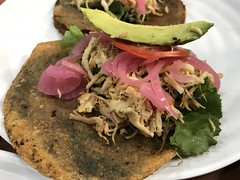 Another great "off Friday" exploring LA, today with the adding bonus of being joined by my husband who decided to take a day off. I introduced him to the Mercado La Paloma foodie food court by USC, where we lunched on a Yucatecan feast of panuchos, tacos de poc chuc and cochinita pibil. Then we wandered over to see the King Tut exhibit at the Calif Science Center. The exhibit features many great artifacts from the tomb, some of which have never before left Egypt. It is beautifully laid out, presenting the artifacts in the context of King Tut's journey through the underworld into the afterlife, the reason all these dazzling treasures were crafted and placed in his tomb. When the tomb was first being opened and Howard Carter first peered in, Lord Carnarvon eagerly asked, "do you see anything?" "Oh yes," he replied, "wonderful things!" We did indeed see wonderful things today. (The exhibit runs through Jan 6, so still time to catch it!) This evening, we went into DTLA for dinner at the vegetable-forward PYT. Even our cocktails featured veggies - a celery margarita and a bourbon with beet.
Another great "off Friday" exploring LA, today with the adding bonus of being joined by my husband who decided to take a day off. I introduced him to the Mercado La Paloma foodie food court by USC, where we lunched on a Yucatecan feast of panuchos, tacos de poc chuc and cochinita pibil. Then we wandered over to see the King Tut exhibit at the Calif Science Center. The exhibit features many great artifacts from the tomb, some of which have never before left Egypt. It is beautifully laid out, presenting the artifacts in the context of King Tut's journey through the underworld into the afterlife, the reason all these dazzling treasures were crafted and placed in his tomb. When the tomb was first being opened and Howard Carter first peered in, Lord Carnarvon eagerly asked, "do you see anything?" "Oh yes," he replied, "wonderful things!" We did indeed see wonderful things today. (The exhibit runs through Jan 6, so still time to catch it!) This evening, we went into DTLA for dinner at the vegetable-forward PYT. Even our cocktails featured veggies - a celery margarita and a bourbon with beet.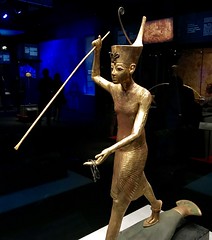 |
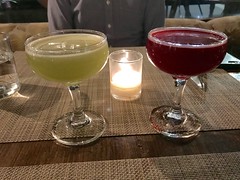 |
 |
Wednesday, October 03, 2018
Why Kavanaugh Shouldn't Be Confirmed
I’d been wanting to write something about my take on the Kavanaugh hearings, but this thoughtful conservative in The Atlantic has gone and written my essay for me. Judicial temperament, credibility, the appropriate standards for the question before the Senate - he hits all the points I’ve been mulling.
Saturday, September 29, 2018
FILM: A Simple Favor
What a wild ride! A Simple Favor was fun, funny, clever, with good twists and turns, you just don’t really know who’s doing what to whom until the very end. Anna Kendrick is always good, but Blake Lively - wow! And Henry Golding, great performance hot on the heels of Crazy Rich Asians. Think Body Heat, Vertigo, or Double Indemnity for the vlog age.
Tuesday, September 11, 2018
STAGE: Love's Labour's Lost
Rounded out our Oregon Shakespeare Festival with a rollicking production of Love’s Labour’s Lost. We anticipated fun when we laid eyes on the eccentric set, and the show filled the promise. Who knew the Bard wrote a rock musical? The costumes were clever too, playing on the color imagery in the language, all white at first, increasingly splashed with tempera paints, then all red in Act IV, and all black at the end. A fair amount of ad libbing suits this play, including a bit with a smartphone. Such good fun!
FOOD: Coquina (Ashland OR)
Another extraordinary dinner in Ashland. Everything was plated like artworks and such innovative dishes of seasonal local ingredients. Started with a fennel custard with wild sturgeon roe, quark (a fresh yogurt cheese), Pernod gelée, beet chips, arugula blossoms, and crispy shallots. A simple chilled artichoke soup with crème fraîche and artichoke chips was silky smooth and full of flavor. Burrata was served with slow-roasted tomatoes and prosciutto with aged balsamic. Our main was a sous vide duck breast with figs, baby potatoes, beech cap mushrooms, pickled ramps (no doubt house-pickled from the spring), with three different puddles of flavor, including a foie/olive purée, a balsamic vinaigrette, and a mustard seed gastrique. Our desserts were a cynar panna cotta with candied artichokes and caramel hazelnuts, and a chocolate truffle tort with cherries and raspberries. (You wouldn’t expect artichoke and cynar - an Italian herbal/artichoke aperitif - to be good in a dessert, but candied and with vanilla, it was an unexpected delight.) This was all complimented with local wines from Goldback, a Grenache rosé and a Rhône blend Cuvée. (We are lightweight drinkers, good for one glass each, and they were lovely to suggest that we could split glasses, so we could have a bit of rosé with the appetizers and the heavier red with our main.)
Sunday, September 09, 2018
STAGE: Romeo and Juliet (OSF)
Just back from a marvelous production of Romeo and Juliet at the Oregon Shakespeare Festival’s Elizabethan Theatre. Very well acted, beautifully staged. That beautiful language, and so heartbreaking no matter how many times you see it. "My bounty is as boundless as the sea, my love as deep, for both are infinite."
Saturday, September 08, 2018
FOOD: Amuse (Ashland OR)
Fantastic first dinner in Ashland at Amuse, a French-inspired bistro featuring local ingredients. Started with an amuse of beet “caviar” on crostini with fresh tarragon. The bread service (including nice gluten-free crackers for George) came with thyme butter and a tasty pepperade of cured peppers, onions, fennel. I started with a carrot soup with cumin and coriander, while G had a beet salad with goat cheese and figs. I had a succulent roast game hen in truffle butter with pole beans and Tokyo turnips, while G had a wild mushroom risotto with zucchini and arugula pesto. They had some really good southern Oregon wines. My Upper Five “Oso Grande” was a Grenache/Syrah /Tempranillo blend, a nice compliment to the truffles, while G had a lovely roussanne/ marsanne/ viognier. (Didn’t hurt that they served in appropriate Riedel crystal glasses.) For dessert, I took the pavlova with fresh blue and blackberries from a local farm, while G had a caramel pot de crème. And the check came with figs in ganache as a mignardise. Quite impressed with this place!
Friday, September 07, 2018
BOOKS: Interpreter of Maladies
Jhumpa Lahiri’s “Interpreter of Maladies” is a charming collection of short stories, some set in her ancestral Bengal region of India, but more often about Bengali immigrants in North America. (Some will recognize her as the author of “The Namesake”, which was also made into a movie.) Her stories often keenly illustrate the tensions of people who have one foot in the old world and one foot in the new, or those between generations of immigrants. Typically the story is told from the perspective of a particular character, and in several, that character is a child. She has a lovely skill of capturing a child’s observations of adult relationships around them. In other stories, characters implicitly wrestle with the meaning of marriage. The nine stories are all very well told, with thoughtfully developed characters, and an enjoyable read.
Saturday, September 01, 2018
FILM: Crazy Rich Asians
What a pleasure to see Crazy Rich Asians. Not only a charming rom com with very likeable attractive leads, some interesting complications, good side characters, and plenty of laughs, tears, and heart-warming scenes, plus the bonus of some good food porn, travel porn, and fashion porn, but on top of all that you get some thoughtful glimpses of tensions between immigrant generations, between old world values and American values, between love and family, between sacrifice and self-fulfillment. Constance Wu is spot on as the Rachel, the heroine, a Chinese-American economics professor at NYU, smart, down to earth, and mostly confident though that is tested. Newcomer Henry Golding is perfectly handsome and charming as Rachel’s boyfriend Nick. Michelle Yeoh is flawless as Nick’s fierce tiger mother, with a nuanced performance that conveys so much with just a look. This film has layers, including nuances of Asian culture that are not elaborated, but add richness to those who will pick up on them. There’s a pivotal scene toward the end of the movie where the heroine confronts her boyfriend’s mother over a game of mahjong. I was very curious about the deeper symbolism that I suspected lay in those tiles and how the mahjong game unfolds. Gotta love the Internet -- I found a great blog post (caution: heavy spoilers!) that explains it, and it does enrich an already wonderful story.
Friday, August 31, 2018
FOOD: Officine Brera
Eating at Officine Brera in the DTLA Arts District always transports us back to fond memories of our trip to Tuscany. The vast room, an old warehouse space (very Arts District), has a modern vibe, and a nice view of the open kitchen, including their wood-burning ovens. (You can see the wood piled up by the front door.) They make some wonderful grilled meats and fish, and one of the ovens has a big crank / pulley thing for lowering down very large roasts. But they also make some terrific pastas. George often goes for the risotto, which tonight was carnaroli superfino rice with foraged mushrooms and Moliterno al tartuffo (a sharp aged pecorino – sheep’s milk cheese – from Sardinia, with veins of black truffle). I went for a new menu item, a venison ravioli with Nebbiolo-braised red onions and arrosto sauce (gravy from the roast). The meat was deliciously dark and rich, and it took me back to a dinner I had in Monteriggioni (an ancient Tuscan walled town) – that dinner was wild boar, but similar dark rich meat and sauce. We’d started this dinner with a light summer aperitif called “the Roz”, a flute of Plymouth gin, blackberry thyme sage shrub, lemon, and prosecco. And we always start with some farinata, a Tuscan chickpea crepe that we were delighted to discover in Florence, as it’s naturally gluten-free. Here at Brera, it is nicely blistered in their wood-burning oven. (It’s not on the menu, you just have to know to ask.) There was a salad of greens, grilled nectarine, lardon bits, chanterelles, and pistachios. And for dessert, a meringue with macedonia of summer fruit including more nectarines and amarena cherries. And of course an espresso.
FOOD: Pizzeria Mozza
Lunch at the famous Pizzeria Mozza: fennel sausage, mozzarella and cream, with slivered scallions and red onion. Thin crust bed that gets thick with beautifully blistered bubbles at the edge. House-made sausage is dollops of deliciously seasoned and cured ground meat (no need for casing just to put it on pizza). Green and red onions are sliced ultra thinly and lightly roasted, softened but still with a little bite and snap. GTK: reservations are scarce but if you’re content to sit at the bar, you can walk in at noon with no wait.
Saturday, August 25, 2018
FOOD: Orsa & Winston
This evening we were treated to the tasting menu at Orsa & Winston in DTLA. If you imagine how a chef with TexMex roots, trained in the classical European tradition, would prepare a Japanese omakase menu using mostly local ingredients from the local farmers market, that’s what you’ll get at Orsa & Winston. As Jonathan Gold said, “It tastes like Italy, Japan, and Spain. It tastes like Los Angeles.” The meal commenced with an amuse bouche of black sesame tofu topped with kombu and smoked trout roe, a rich dark bite set in a lovely blue-and-white patterned bowl. First course was a kanpachi (amberjack) crudo, fresh and mild, in a light yuzu dressing with red and yellow heirloom tomatoes and a couple little dollops of avocado, making a colorful array across a plain white plate. Next up was a duck foie gras au torchon, garnished with huckleberries, white figs, and labneh, with toast to spread the smooth rich pâté on. The “second course” (as is traditional with tasting menus, a “six course menu” ends up being more like ten) was a chilled summer melon soup, sweet cantaloupe-colored juice poured over some Hokkaido scallops, slivers of jicama, and little pieces of oro blanco grapefruit and cucumber. Third was a piece of seared aji (mackerel) with seared baby corn, malabar spinach, and a chopped walnut bagna cauda. (Yeah, I don’t know what all that stuff is either, and we often consult Google while decoding menus. Bagna cauda is a Piedmontese dipping sauce made from olive oil blended with garlic and anchovy. Don’t let the anchovy put you off. It’s all blended in, just good tasty dressing, here with chopped walnut added.) Fourth up was a “satsuki rice porridge”, like a risotto but with a short-grained plump Japanese rice and seasoning, with slices of abalone, pieces of geoduck (a long-necked clam), and Santa Barbara uni (sea urchin). Fifth, the meat course, was a Sonoma lamb T-bone with cannellini beans, cherry tomatoes, maitake mushrooms, some dark leafy green, and some minced castelvetrano olives. A palate cleanser of coconut sorbetto with passionfruit pulp was a lovely light segue into dessert, which was a peach clafoutis with a hearty dollop of crème fraiche Chantilly. (If you’re again diving for Google, a clafoutis is a custardy batter mixed with fruit and baked, so that unlike a pie or a cobbler, the fruit is baked right into the pastry. To be appropriately decadent, we did the wine pairings, which were really interesting. Though all Italian and French, the varietals and regions were mostly unfamiliar ones: a folle blanche from the Loire was very tart to pair with the crudo, a lagrein from the Dolomites made a dark rosato with berry notes that made a lovely compliment to the melon soup, and a dry white sciaglin from Venezia-Giulia made for pasta and aged cheese paired nicely with the rice porridge and shellfish. The desert wine was a moscato from Sicily where they press the grapes earlier, not letting them turn into raisins as is more typically done, for a light sweetness instead of a more typical syrupy moscato. It was lovely with the light pastry, fruit, and cream. We parted happy from good company and the tastes of Los Angeles in our bellies, feeling lucky to live in this city. (See full set of photos here.)
Friday, August 24, 2018
Long Beach: CambodiaTown and Judithe Hernández at the MoLAA
With another off-Friday opportunity to explore my city, I headed down to Long Beach. For lunch, Cambodian food was on the menu. In one of those quirks of human migration patterns, the stream of Cambodian emigrants in the wake of the 1979 fall of the Khmer Rouge regime ended up concentrating in Long Beach, and creating a CambodiaTown along Anaheim Blvd. Arguably ground zero of CambodiaTown has been a place called Sophy’s (or also called CambodiaTown Food & Music), a restaurant but also a bit of market and community center. I’d been tipped off by Eater.com that a dish called amok trey was a great intro into authentic Cambodian cuisine. Amok trey is made from catfish fillets rubbed with kroeung -- a curry paste, and steamed with red and green peppers -- and some leafy veg with a stalk (similar to Chinese broccoli). The curry paste has similar ingredients to Thai curry - lemongrass, galangal, chili, kaffir lime - but a bit more sour than Thai. This fish was mild, tender, and delicious.
After lunch, my culture target was the Museum of Latin American Art, where a new exhibition of Judithe Hernández had just opened. I wasn’t familiar with the artist, but when I saw some of the striking images of her work, and when I learned that she was a cohort of Carlos Almaraz, whose work I’d really appreciated at a LACMA exhibit last summer, I knew I wanted to check it out. As the only female artist in the art collective Los Four, and one of the few female artists in the Chicano art movement at all, she developed a strong feminist identity expressed in her work. She works almost exclusively in pastel on paper, with figurative depictions of women, with a dream-like quality that conveys these women as archetypes to be read symbolically rather than portraits of specific actual women. A number of her works are set in vivid botanical landscapes, Rousseau-like jungle foliage or desert scapes, and some contain dream-like animals. This sort of magical realism will suggest comparisons to Frida Kahlo, but Hernández has her own clearly distinct style and vision. A number of the pieces express pointed commentary on contemporary events. One set, called the Juarez series, reflects on the spate of random murders of women and girls around Ciudad Juarez. There have been hundreds of these “feminicides” since 1993, with no apparent motive, just women violently killed, their bodies left in the desert. In The Unknown Saint, a ghostly woman on her back seems to float above a stand of cactus in the desert under a full moon night sky, a thin blood-red ribbon coiled around her grey neck and trailing off different directions into the expanse of desert. This large mural is hauntingly beautiful. In another part of the Juarez series, a trilogy of small portraits of women echoes a European Renaissance tradition of aetatis suae portraits, in which families with marriageable young daughters would have portraits painted, annotated with the age of the girl and the year, for circulation around society soliciting suitors. Here Hernández, in a biting riff on the classical form, has painted portraits of young women with their age and year of their untimely deaths. Another very recent work, reacting to then-candidate Trump’s comments on Mexican immigrants, draws on a Spanish Colonial tradition of dressing deceased infants in saintly garments. Her Death of the Innocents memorializes a young child lost to the dangers of attempts to cross the northern Mexican deserts to get the United States. The deceased child is dressed as a saint, with red and green sashes (colors of the Mexican flag), and holding a ribbon that says “we come but to dream”. Though mortality is certainly a prevalent theme in her work, it’s not entirely pervasive. Other works (like Jungle of Fire, The Birth of Eve, and Garden of Dreams) are vivid dreamscapes. Some are provocative in other ways. Les Desmoiselles d’Barrio is her feminist pastiche of Picasso's seminal work, Les Desmoiselles d'Avignon. Her desmoiselles are much more formidable, with luchadora (Mexican wrestling) masks, and some armed with rapiers. For Hernández, women have layers of masks. Even with their luchadora masks removed, these women's faces are identical, and appear stitched onto their heads.
After being immersed in the colorful dreamlands of Judithe Hernández, I stepped into the sunlight of the Gumbiner Sculpture Garden, where a collection of modern sculpture by Latin artists is set amidst cactus and palms. A few particularly caught my eye. I liked Gaudi Esté’s Perro Nagual con cara de conejo (rabbit-faced dog spirit), a figurative bronze howling at the moon. In Williams Barbosa’s Danza no 1, the curve and sweep of the two tall red iron abstracts had be thinking “Fred and Ginger” before I even saw the title. Carlos Luna’s comic War-Giro looks like a goofy sheriff from the front with his skeleton exposed on the back. Gustavo López Armentia’s Objetos del Mundo (objects of the world) is a monumental fork and knife with hieroglyphic-like symbology (more worldly objects) carved into them when you look up close. All in all, definitely worth the short drive down to Long Beach. (See complete set of photos from the day here.)
After lunch, my culture target was the Museum of Latin American Art, where a new exhibition of Judithe Hernández had just opened. I wasn’t familiar with the artist, but when I saw some of the striking images of her work, and when I learned that she was a cohort of Carlos Almaraz, whose work I’d really appreciated at a LACMA exhibit last summer, I knew I wanted to check it out. As the only female artist in the art collective Los Four, and one of the few female artists in the Chicano art movement at all, she developed a strong feminist identity expressed in her work. She works almost exclusively in pastel on paper, with figurative depictions of women, with a dream-like quality that conveys these women as archetypes to be read symbolically rather than portraits of specific actual women. A number of her works are set in vivid botanical landscapes, Rousseau-like jungle foliage or desert scapes, and some contain dream-like animals. This sort of magical realism will suggest comparisons to Frida Kahlo, but Hernández has her own clearly distinct style and vision. A number of the pieces express pointed commentary on contemporary events. One set, called the Juarez series, reflects on the spate of random murders of women and girls around Ciudad Juarez. There have been hundreds of these “feminicides” since 1993, with no apparent motive, just women violently killed, their bodies left in the desert. In The Unknown Saint, a ghostly woman on her back seems to float above a stand of cactus in the desert under a full moon night sky, a thin blood-red ribbon coiled around her grey neck and trailing off different directions into the expanse of desert. This large mural is hauntingly beautiful. In another part of the Juarez series, a trilogy of small portraits of women echoes a European Renaissance tradition of aetatis suae portraits, in which families with marriageable young daughters would have portraits painted, annotated with the age of the girl and the year, for circulation around society soliciting suitors. Here Hernández, in a biting riff on the classical form, has painted portraits of young women with their age and year of their untimely deaths. Another very recent work, reacting to then-candidate Trump’s comments on Mexican immigrants, draws on a Spanish Colonial tradition of dressing deceased infants in saintly garments. Her Death of the Innocents memorializes a young child lost to the dangers of attempts to cross the northern Mexican deserts to get the United States. The deceased child is dressed as a saint, with red and green sashes (colors of the Mexican flag), and holding a ribbon that says “we come but to dream”. Though mortality is certainly a prevalent theme in her work, it’s not entirely pervasive. Other works (like Jungle of Fire, The Birth of Eve, and Garden of Dreams) are vivid dreamscapes. Some are provocative in other ways. Les Desmoiselles d’Barrio is her feminist pastiche of Picasso's seminal work, Les Desmoiselles d'Avignon. Her desmoiselles are much more formidable, with luchadora (Mexican wrestling) masks, and some armed with rapiers. For Hernández, women have layers of masks. Even with their luchadora masks removed, these women's faces are identical, and appear stitched onto their heads.
After being immersed in the colorful dreamlands of Judithe Hernández, I stepped into the sunlight of the Gumbiner Sculpture Garden, where a collection of modern sculpture by Latin artists is set amidst cactus and palms. A few particularly caught my eye. I liked Gaudi Esté’s Perro Nagual con cara de conejo (rabbit-faced dog spirit), a figurative bronze howling at the moon. In Williams Barbosa’s Danza no 1, the curve and sweep of the two tall red iron abstracts had be thinking “Fred and Ginger” before I even saw the title. Carlos Luna’s comic War-Giro looks like a goofy sheriff from the front with his skeleton exposed on the back. Gustavo López Armentia’s Objetos del Mundo (objects of the world) is a monumental fork and knife with hieroglyphic-like symbology (more worldly objects) carved into them when you look up close. All in all, definitely worth the short drive down to Long Beach. (See complete set of photos from the day here.)
Saturday, August 18, 2018
The Difference Between A President And A Dictator
The difference between a president and a dictator is that a president presides over a nation of laws where the power of government can only be wielded with due process, while a dictator is an exercise of power at will, doing whatever he wants merely because he wants to. In our constitutional republic, no president should be allowed any arbitrary exercise of power that allows him to punish anyone he deems to be his enemy. Yet that is precisely what is happening with Trump acting to revoke the security clearance of former senior intelligence officials who criticize him. It is not only retaliation against Trump’s perceived enemies, but it is fully intended to send a message to others. This politicization of the security clearance process must not be tolerated. This is completely Nixonian territory. With Nixon, it was using the IRS to inflict tax audits as harassment, and using federal contracts and grants as the president’s personal tokens of favor or disfavor. A then-secret internal memo from the Nixon White House outlined “how we can use the available federal machinery to screw our political enemies”. (Yes, that’s a quote.) This abuse of power was among the articles of impeachment against Nixon. What Trump has done to John Brennan, and is threatening to do to others, is no different. This is behavior one would expect from the leader of Cuba or Zimbabwe or Russia, but not the United States.
Friday, August 17, 2018
ART: Sparrow Mart
This evening my husband and I stopped by Sparrow Mart, a unique art installation at The Standard Hotel DTLA. British artist Lucy Sparrow works almost exclusively in felt and makes what are essentially hand-painted felt plushies. She and a small crew of crafters in her studio hand-made 31,000 items that are replicas of things you would find in a typical southern California market, and stocked an entire market. Plushy condiments, plushy candy bars, plushy cigarettes, a deli case, a seafood counter with little plushy clams, scallops, and salmon filets, plushy sushi. There's a full-size felt ATM spitting out a felt receipt and felt money. The detail is delightful. It's so whimsical and so inventive, you can't help but smile in amazement. These items are all actually on sale, and there are market baskets and a check-out counter. We saw people loading up their baskets. This unique art exhibit will be on display through the end of August, or until the shelves are empty, whichever comes first!
Wednesday, August 15, 2018
BOOKS: Kitchen Confidential
For some ridiculous reason, I had somehow managed to not really know who Anthony Bourdain was until after his death. The outpouring of praise in response to his tragic end finally motivated me to see what I’d been missing, so I picked up his first big book Kitchen Confidential: Adventures in the Culinary Underbelly. I’m way late to join the chorus, but I will heartily join the voices of praise. As promised, the book is an eye-opening tour of the “back of house” of the restaurant business, giving me a whole new appreciation for what goes on back there. We think of chefs as being all about the culinary creativity, but that’s just a small part of the job, which includes marshalling supplies of food and tools from a network of suppliers of varying scrupulousness and reliability, managing a staff mostly comprised of miscreants and undocumented immigrants, and playing HR, confidant, and motivator to get them to produce a consistent high quality product at intense volume. His description of the pre-theatre dinner rush at a Times Square eatery will make you appreciate a chef not just as a food artist, but also like Omar Bradley planning and executing the landing at Utah Beach. His description of the colorful characters that inhabit the kitchen, and the choreography that somehow emerges from barely controlled mayhem, will make you want to peek behind the kitchen door, but will also make you very afraid to get too close. Bourdain has the rare gift of writing like he talks (and bonus: he reads his own audiobook), and the book is not only a window on the restaurant world, but also a window on this extraordinary man. He is impressed with his own talents, sometimes self-confessedly beyond justification, but he has a deep respect for his craft, and is quick to take his hat off to his peers and superiors. He desires to do a good job for its own sake, and gives restaurant owners their due if not always respect, but he’s fiercely loyal to his employees. His prose is vivid, and I enjoyed the journey from Bourdain as a boy in France tasting his first oyster to the seasoned chef making his first explorations of the Tokyo food scene, or just the chef examining his own hands, their scars, and the stories they tell. I’m sorry I didn’t know him sooner. I miss him already.
Sunday, August 12, 2018
Attempt to Neuter the EPA Under Guise of Scientific Transparency
We have until Thursday, Aug 16, to provide comments on a proposed EPA rule that is intended to neuter the EPA’s ability to regulate air pollution, water contaminants, and toxic chemicals. It’s a parting gift from recently-resigned-in-disgrace EPA Administrator Scott Pruitt, whose aim in running the Environmental Protection Agency was essentially to stop protecting the environment. The rule is actually a bit of evil genius. It cloaks itself in lofty aims of scientific transparency, requiring the EPA to consider only scientific studies whose data sets are publicly available for replication. It sounds quite reasonable on the surface, until you realize that medical studies inevitably involve confidential medical information about actual people, and that making their data sets public would mean publishing the private medical info of all those people who participated in the study. That’s obviously a non-starter, and the effect would be that in trying to decide whether certain chemicals and pollutants are harmful to human health, the EPA would be prohibited from consulting any scientific studies involving humans. And if the EPA’s own rules keep it from looking at medical studies to see whether chemicals cause any harm, then they can’t make any regulations enforcing safety measures. This is the dream of those like Pruitt who believe that science itself is just a liberal conspiracy to thwart business growth by making pesky regulations against dumping toxic waste into our rivers and harmful particulates into our air. If you care about clean air, clean water, and a healthy environment, you will want to comment on this proposed rule.
If you want to read more about it, there’s a great article in The Atlantic here: https://www.theatlantic.com/science/archive/2018/07/scott-pruitts-secret-science-rule-could-still-become-law/565325/
You can read the actual proposed rule and comment on it here: https://www.regulations.gov/document?D=EPA-HQ-OA-2018-0259-0001
Here is the comment that I submitted:
If you want to read more about it, there’s a great article in The Atlantic here: https://www.theatlantic.com/science/archive/2018/07/scott-pruitts-secret-science-rule-could-still-become-law/565325/
You can read the actual proposed rule and comment on it here: https://www.regulations.gov/document?D=EPA-HQ-OA-2018-0259-0001
Here is the comment that I submitted:
I am deeply concerned about the effect this proposed rule would have on the ability of the EPA to protect human health, as is its charter. As should be well known to the EPA, most large-scale medical studies inherently involve data sets bound up in patient privacy, with specific medical details such that anonymization or redaction of the data would be impossible without compromising either privacy or replicability. The upshot of this rule is that when evaluating policies on air pollution, water contaminants, and toxic chemicals, and their effect on human health, the EPA would be prohibited from consulting any scientific research on actual humans. Even though this rule is written to affect only prospective rulemaking, its effect should be studied by looking at how past rules might have come out differently had this rule been in effect. A good example is the 1993 Harvard “Six Cities” study that was pivotal in establishing EPA policies regulating particulate matter, but which is often cited as so-called “secret science”. This study, which is a model for responsible science, having established protocols to support replication without violating patient confidentiality, has been replicated both in independent reviews of its own data set, and in similar studies of other data sets. Yet, because it cannot make its data public without violating patient confidentiality, it would be excluded by this rule, and if the rule were given retrospective effect, we could well lose well-founded health protections against the harms of particulate matter. I submit that any rule that would exclude studies such as this one violates the EPA’s fundamental charter to protect human health, and must be revised. And it would not be sufficient to rely on discretionary exceptions to allow studies such as this. These type of studies are the norm, and not the exception, and must be accommodated by any EPA rule fundamentally and not just on an exceptional basis.
Saturday, August 11, 2018
STAGE: Waitress
 The heroine of the musical Waitress is Jenna, who works at a diner in an unnamed southern town, and has a creative genius for making pies with fanciful names and unexpected combinations of ingredients. This show takes an unexpected combination of ingredients – an abusive husband, an unwanted pregnancy, extramarital affairs, women trapped by hard economic circumstances – and bakes all of that into an unexpectedly delicious feast for the eyes, ears, and heart. The choreography is impressive, with the cast dancing around and the diner’s tables, tray carts, and pantry shelves often playing moving parts in the dance. The Sara Bareilles tunes are charming with witty lyrics that define the characters and propel the story, and Desi Oakley as Jenna does a great job serving them up with impressive stylings like falls and runs near the end of big long notes. Charity Angél Dawson was sassy as Jenna’s friend and co-worker Becky, and shined in her big number “I Didn’t Plan It” at the top of Act Two. And Oakley has some lovely duets with Bryan Fenkart (Dr. Pomatter), particularly “A Really Good Bad Idea” at the end of Act One. Despite some dark and heavy themes, there’s enough sugar in this pie to balance it. I smiled a lot and laughed, including a couple tipping-head-back roaring laughs, at the same time as appreciating its more serious commitments, but it is dessert in the end. If you have a chance to catch this while it’s still at the Pantages (through Aug 26), we recommend it.
The heroine of the musical Waitress is Jenna, who works at a diner in an unnamed southern town, and has a creative genius for making pies with fanciful names and unexpected combinations of ingredients. This show takes an unexpected combination of ingredients – an abusive husband, an unwanted pregnancy, extramarital affairs, women trapped by hard economic circumstances – and bakes all of that into an unexpectedly delicious feast for the eyes, ears, and heart. The choreography is impressive, with the cast dancing around and the diner’s tables, tray carts, and pantry shelves often playing moving parts in the dance. The Sara Bareilles tunes are charming with witty lyrics that define the characters and propel the story, and Desi Oakley as Jenna does a great job serving them up with impressive stylings like falls and runs near the end of big long notes. Charity Angél Dawson was sassy as Jenna’s friend and co-worker Becky, and shined in her big number “I Didn’t Plan It” at the top of Act Two. And Oakley has some lovely duets with Bryan Fenkart (Dr. Pomatter), particularly “A Really Good Bad Idea” at the end of Act One. Despite some dark and heavy themes, there’s enough sugar in this pie to balance it. I smiled a lot and laughed, including a couple tipping-head-back roaring laughs, at the same time as appreciating its more serious commitments, but it is dessert in the end. If you have a chance to catch this while it’s still at the Pantages (through Aug 26), we recommend it.Sunday, August 05, 2018
Say No To Census Citizenship Question
This Tuesday Aug 7 is the deadline for public comment on an insidious proposal to add a citizenship question to the 2020 census. While that may seem innocuous, one should appreciate how fraught the current situation is for non-citizens in America today, and how unlikely they would be to respond to a government questionnaire asking about citizenship. Why is it important to count non-citizens? Our US Constitution requires a census every ten years to enumerate all residents for the purpose of apportioning representation. Note that this count is specifically of residents and not just citizens, and the census has counted non-citizens since the first census in 1790. If the non-citizen population of California (and other states with a higher share of immigrants) is undercounted, California could be apportioned fewer representatives in Congress and fewer electoral votes. At a time when immigration policy is being hotly debated, it is crucial for the states who actually have the most at stake to have the appropriately apportioned voice in the debate.
Anybody is invited to comment on the proposed government action. Follow this link: https://www.regulations.gov/docket?D=USBC-2018-0005 and look for the “Comment Now” button. Your comment can be as brief or lengthy as you like, and feel free to add any personal perspective or examples on how this could affect you. Here was my comment:
I strongly urge the Commerce Department to remove the citizenship question from the 2020 Census form. Including an untested, controversial question will undermine the quality and accuracy of the census. The Census Bureau's own Chief Scientist warned of lower response, much higher costs, and a less accurate census if the citizenship question is included (see note 1). Including a citizenship question puts the census at grave risk of a significant undercount, especially among hard-to-reach population groups that already are fearful of answering government surveys, according to the bureau's own research. An accurate enumeration of residents is the constitutional charge of the census, and a citizenship question must not be allowed to jeopardize that constitutional purpose for the census. Moreover, the apparent political motivation of the late addition of a citizenship question (see note 2, e.g.), and the apparent top-down direction to add this question despite contrary advice from agency experts, threatens to erode public faith in fundamentally non-partisan government functions such as the Bureau of the Census. At a time when public faith in government institutions is ebbing, we can ill afford such a mistake.
(1) Memo from John M. Abowd, "Technical Review of the Department of Justice Request to Add Citizenship Question to the 2020 Census", 19 Jan 2018.
(2) “Document Sheds Light On Decision To Add Census Citizenship Question”, NPR, 10 Jun 2018.
Anybody is invited to comment on the proposed government action. Follow this link: https://www.regulations.gov/docket?D=USBC-2018-0005 and look for the “Comment Now” button. Your comment can be as brief or lengthy as you like, and feel free to add any personal perspective or examples on how this could affect you. Here was my comment:
I strongly urge the Commerce Department to remove the citizenship question from the 2020 Census form. Including an untested, controversial question will undermine the quality and accuracy of the census. The Census Bureau's own Chief Scientist warned of lower response, much higher costs, and a less accurate census if the citizenship question is included (see note 1). Including a citizenship question puts the census at grave risk of a significant undercount, especially among hard-to-reach population groups that already are fearful of answering government surveys, according to the bureau's own research. An accurate enumeration of residents is the constitutional charge of the census, and a citizenship question must not be allowed to jeopardize that constitutional purpose for the census. Moreover, the apparent political motivation of the late addition of a citizenship question (see note 2, e.g.), and the apparent top-down direction to add this question despite contrary advice from agency experts, threatens to erode public faith in fundamentally non-partisan government functions such as the Bureau of the Census. At a time when public faith in government institutions is ebbing, we can ill afford such a mistake.
(1) Memo from John M. Abowd, "Technical Review of the Department of Justice Request to Add Citizenship Question to the 2020 Census", 19 Jan 2018.
(2) “Document Sheds Light On Decision To Add Census Citizenship Question”, NPR, 10 Jun 2018.
Saturday, August 04, 2018
FILM: Mamma Mia! Here We Go Again
It’s Wednesday morning and I still have those catchy Abba tunes playing in my head from seeing the new Mamma Mia movie on Saturday, along with visions of breezy sunny romances on gorgeous Greek islands. If you liked the first Mamma Mia, you’ll like this new installment even better. This prequel/sequel interleaves story lines of Sophie sometime after the first film leaves off and a young Donna showing us the events that lead to her landing on a remote island and getting pregnant with uncertain paternity. Not only do the writers work in excuses for a whole party of Abba tunes, but they also flesh out Donna’s back story fitting in every hint that we’d heard about it before. Lily James gives a great performance as young Donna, and we meet a charming trio of young actors playing the three possible fathers. Amanda Seyfried equally shines in her return as Sophie, and a bunch of familiar actors from the first film are fun to see again. Meryl Streep, when she turns up, is wonderful and made me cry. The only disappointment was Cher, whom you’d think would be a natural playing a big diva, but came across unexpectedly flat and frail (though in fairness the script gave her only a cardboard character to work with). But that small off note didn’t spoil the party. We laughed, we cried, and we walked out smiling and humming.
Thursday, August 02, 2018
FILM: Marshall
Chadwick Boseman made two superhero movies this past year, and I just got the chance to watch the other one. Both heroes were endowed with great intellect and judgment in their quest for justice, but unlike the Black Panther whose physical abilities were enhanced by technology and magic herbs, Thurgood Marshall's only power was the law, and an appeal to his fellow citizens' sense of justice. It was not a superpower that enabled him to overcome two-on-one odds in a bar fight, but it was a superpower that enabled him to win over a reluctant co-counsel, a white jury in Connecticut in 1941, and over time help transform a nation. The story is at core a good old-fashioned courtroom drama, very black-and-white, if you will, about which side to root for, and just enough twists to provide a reasonable doubt about the inevitable outcome. The film does a great job of capturing the time and place, with a color palette that gives that vintage impression of sepia tone, while actually being in color. It also conveys the racial atmosphere of the time and place, showing us that a black defendant getting a fair trial wasn't a problem limited to the South, as well as showing the personal courage and the obstacles large and small faced by these early crusaders for racial justice in the courts. Crusaders is plural here, as, though the young cock-sure Thurgood Marshall is the main hero, this is also the origin story of lesser-known crusader Sam Friedman, a Jewish attorney who gets dragged into this case unwittingly as local counsel, but by the end, finds his calling with the NAACP. Bravo both to Boseman and Josh Gad for their sensitive portrayals of these heroes. Especially at this moment in our history, it is good to be reminded which way the arc of the moral universe bends.
Sunday, July 22, 2018
Remembering Jonathan Gold
I was immensely saddened last night to learn of the untimely passing of Jonathan Gold. I regret never meeting him, but we shared a love of food and of our city, and Los Angeles will not be the same without his intelligent, insightful guidance on our dynamic food scene. As a regular guest on the KCRW “Good Food” podcast with Evan Kleiman, his voice was a regular guest in my car. His column in the LA Times food section was the first thing I would consume on Saturday mornings. Los Angeles has become one of the most vibrant food scenes in the world, and if any one person could claim credit for making that happen, Jonathan would be a top contender. This vast and dynamic city, fueled by the confluence of streams of human migration from the south and the east, a megalopolis of ethnic pockets, ever-transitioning neighborhoods, and cultural mash-ups, has a staggering array of food cultures on offer that can be bewildering and overwhelming. Jonathan provided us a map. For his avid readers, he inspired us to visit unfamiliar neighborhoods, enter establishments sometimes beyond our comfort zone, persevere past menus in languages we couldn’t always read, and put things in our mouths we never dreamt of before (but would dream of after). When he started writing, food critics generally only paid attention to white table cloth, mostly French or “Continental” restaurants, measuring shortness against a particular idea of perfection, their prose often filled with attitude and the caustic cleverness of a Scalia dissent. Jonathan smashed that mold. While he appreciated and lauded the finest high-end restaurants, he could find equal appreciation and praiseworthiness in the craft of an immigrant who sells street corn from a cart on a corner in Lincoln Heights made in the specific style of the particular region in Mexico that he came from. He famously started his career by eating at literally every establishment on Pico Boulevard (one of LA’s long boulevards that stretches 15 miles from downtown to the beach). And by the time he was done, he no longer spoke of Mexican food or Chinese food, but had taught himself -- and went on to teach us -- about the wonderful differences between the styles of Oaxaca, Jalisco, or Guerrero, or the specifics of Chengdu distinct from other parts of Sichuan. He was a scholar and guide to the food regions of Thailand, Korea, and Vietnam, and the subtleties of Honduran vs Guatemalan vs Salvadoran foods. He probably knew more about Korean food than most Koreans in Koreatown. His infectious enthusiasm inspired non-Koreans to venture into K-town, and non-Latinos to venture into East LA. He fomented an openness and an invitation to cross-cultural exploration in this city, and I might venture that he did as much as anyone to cultivate the appreciation and create the cultural space for someone like Roy Choi to take LA by storm with his Kogi truck, mashing up Korean and Mexican food. And Jonathan’s smashing of the cult of the white table cloth paved the way to a city where some of our top-rated restaurants are food trucks whose location you need to follow Twitter to pin down. I am deeply grateful for how much he has enriched my own life, as he has countless Angelenos, with his insights, his encyclopedic knowledge, his contagious enthusiasm, and his delightful prose. His death – way too soon – leaves a huge hole in the heart of our city.
Friday, July 20, 2018
FILM: Postcards From London
It’s always fun to see Outfest films at the Ford, an outdoor theater that is lovely for a summer night screening. This year, we enjoyed Postcards From London, an unconventional story of a young man coming to London with little money but big dreams, and falling in with a group of high-end male escorts who are aficionados of baroque art, and who serve clients who want discreet sex and sophisticated conversation. (“We’re not prostitutes, we’re raconteurs.”) Though the film is mostly dramatic, it has some good comedic breaks, particularly a very amusing scene where the young man is in a hotel room with a client reenacting the martyrdom of Saint Sebastian. The lead is beautifully played by Harris Dickinson, whom we met in last year’s film Beach Rats, which makes for an interesting comparison. While Dickinson gave great performances in both, Beach Rats was full of destructive self-loathing and was painful to watch. Postcards, in contrast, is free of shame for being gay, for enjoying role-playing, or even for doing sex work. The only shame in this film is for those who fail to appreciate great art. The film is stylish and surreal, including flashbacks to the time of Caravaggio, who is the ultimate hero to the “raconteurs”. While there are a few glimpses of the art itself, director Steve McLean doesn’t give the actual paintings as much camera love as one might expect for a film about art lovers (unlike, for example, the way Mike Leigh featured paintings in Mr. Turner). His focus is more on evoking the look and feel of Soho street life and bar life, and though it is done in quite a stylish way, somehow the style struck me as more reminiscent of Stanley Kubrick (think A Clockwork Orange) than the painterly Peter Greenaway. Similar to another great Kubrick film, Postcards ends with some kind of transformative breakthrough, though I couldn’t tell you exactly what happened. In any event, we did enjoy the film.
Wednesday, July 04, 2018
The Underminer
I haven’t seen the new Incredibles film yet, but at the end
of the first film, we get a preview of a new villain, the Underminer, who emerges
from underground declaring “I am always beneath you, but nothing is beneath me.”
What a perfect symbol for the current U.S. president, who not only is presiding
over a pandemic of repugnant and ill-informed policies, but is actively
undermining core values, principles, and institutions that have made our
country great. To prove this (in honor of the Fourth of July), let Facts
be submitted to a candid world.
- His
personal business interests remain a massive ongoing conflict of interest.
His charade of putting his personal business into a blind trust run by his
sons is about as blind as a surprise present wrapped in cellophane with the
purchase receipt taped on the outside. His taxpayer-funded summits at
Mar-a-Lago and his other properties line his own pockets while providing ongoing
product placement opportunities. And what foreign dignitary courting favor
doesn’t stay at the Trump Hotel in DC? It’s an emoluments extravaganza,
and an in-our-faces flouting of basic business ethics.
- Petty
corruption is rampant, as we’ve seen a steady parade of his cabinet
secretaries taking personal trips at government expense, often in first
class, spending lavish amounts on office furnishings, and using government
employees as their personal servants.
- He (and
his press secretary) have a reckless disregard for truth and facts.
Politicians have always engaged in spin, but this president has taken it
to a whole new level. We are in Orwellian “newspeak” territory when a
president can outright lie to the American people so casually, openly, callously,
and egregiously, even so far as to claim not to have said things that
anyone can see he said just by scrolling back in his Twitter feed. His
very relationship to reality is demonstrably pathological.
- He
has alienated allies so solidly longstanding that such alienation was
inconceivable before this administration. Who could have imagined we would
pick a fight with Canada? Or question our commitment to NATO? And to what
end? He has gained us nothing while damaging the very core alliances that
we need to help keep the world secure. Suddenly those who would never have
questioned the alignment of our interests with theirs are raising those
questions, and that can only be to our detriment.
- He
has not only given regard to odious dictators but openly expressed admiration
and envy of dictatorial powers. When President Xi Jinping became president
for life in China, he said we should try that here. In appraising Kim
Jong-un as a “strong head of his country”, he was envious of how
deferential the North Koreans are to their “dear leader”. “When he speaks,
they sit up at attention!”
- He
dishonors treaties with wanton disregard. He cynically and disingenuously
claimed a “national security” exemption in “justifying” his steel tariffs –
against Canada and Europe. He essentially abrogated the Iran Treaty by falsely
certifying that Iran was not in compliance. He pulled out of the Trans-Pacific
Partnership, often threatens to renegotiate NAFTA, and now is indicating
he wants to pull out of the World Trade Organization. Whatever one thinks
of the pros and cons of particular deals, it shouldn’t be hard to
understand that making a practice of reneging on treaties undermines our
national integrity and devalues our ability to make treaties in the future,
if other nations cannot take us at our word, or cannot rely on treaties to
be any more enduring that the administration that made them. I guess integrity
wasn’t covered in The Art of the Deal.
- He
has no discernable core values, principles, or even strategic goals. Nobody
can speak for or rely upon what he wants, because it changes daily or hourly
with whoever last got his ear and played to his ego. The presidency is
transformed into a personality cult rather than an administration, and one
even has to feel a little bit sorry for the Republican Congressional
leadership who dance and tip-toe around him like an abused and battered spouse
desperately trying to guess from which direction the next smile or strike
will come.
- He
has given comfort and encouragement to the most vile expressions of racism
and nativism. White nationalists, once marginalized by decent society, are
now coming out like cockroaches when the lights go out. They speak and march
openly, as this president sees “very fine people on both sides”.
- He
has stoked baseless fears that immigration is dangerous to our country and
harmful to our economy, working actively to repress all immigration, legal
or otherwise, and turn away those seeking asylum. He has employed the most
vicious and inhumane tactics, such as jailing asylum-seekers and separating
children from their parents, in attempts to discourage them.
- To
some agencies, he has appointed leaders bent against the very charters of
the agencies they lead. The head of the EPA opposes regulation to protect
the environment. The head of the Consumer Financial Protection Bureau doesn’t
want the government protecting consumers. The Secretary of Education is an
opponent of public education.
- To
other agencies, he has appointed leaders who are incompetent and
unqualified. The Secretary of Energy had no idea what the Department of
Energy did when he was appointed to it, and the Department of Housing and
Urban Development is lead by a man who has no experience whatsoever in
housing, urban development, or running a large organization. Competence
and expertise mean nothing in this administration (which is hardly
surprising, since the president himself has no competence or relevant
experience for his own job).
- Through
a combination of sheer maladministration and malice to government itself,
he has hollowed out the agencies of the federal government. Career civil
servants, many who served faithfully through numerous administrations both
Democratic and Republican, have resigned in droves if they haven’t been
sacked out of paranoid fears of “the deep state”. (Those are the real
witch hunts.)
- When
any governmental organization or institution challenges him, he takes to
Twitter to malign their overall integrity. When the FBI investigates him, he
declares the FBI is corrupt. When a federal judge restrains his action, he
declares the judge partisan. When members of Congress oppose him, he hurls
personal insults and accusations. When newspapers report accurately on his
malfeasance, it is all “fake news”. His mudslinging not only degrades the reputation
of his own office, but it slowly corrodes general faith in public
institutions.
The stone walls of a castle are strong and durable, but can
be brought down when the ground beneath them is weakened and the mortar of
their foundations is corroded by undermining. Under the administration of this
Underminer-in-Chief, I fear for the future of our republic.
Monday, July 02, 2018
Roe Is In Danger, But It Doesn't Stop There
On a bright note, last week the Iowa Supreme Court struck down yet another of those unending legislative attempts to chip away at women’s rights to make their own reproductive choices. The decision was 5-2. On a less bright note, one of the two dissenters, Justice Edward Mansfield, is on the published short list of potential nominees to replace Justice Kennedy on the US Supreme Court. Being the constitutional law geek that I am, I thought I would take a look at his dissent. It was terrifying. Not only does he show thinly veiled hostility to Roe v. Wade, but he is completely up front in his opposition to “substantive due process”, the constitutional theory that certain fundamental rights may not be infringed by government. Mansfield is not distinctive here. This philosophy is a hallmark of the Federalist Society, the conservative legal society that has been diligently recruiting a whole new generation of “textualists” and “originalists”, and to whom the President has completely outsourced his pool of Supreme Court nominees. Hiding behind these academic terms of legal interpretation, their goal goes well beyond overturning Roe v. Wade. They would basically overturn every great landmark decision of the last century. That’s where their “war on substantive due process” inevitably leads. Think that consenting adults have a constitutional right to have sex in the privacy of their own home? The Federalist Society does not. Lawrence v. Texas, which declared sodomy laws unconstitutional rests on substantive due process, and they would overturn that. Think that you have a fundamental right to marry another unmarried adult of your choice? The Federalist Society does not. Not only does Obergefell, the 2016 gay marriage case, rest on substantive due process, but so does the 1967 Loving v. Virginia, which affirmed the right of people to marry across racial lines. Do you think a lawfully married couple has the right to use contraception? In 1965, the Supreme Court in Griswold v. Connecticut found a fundamental right to make such intimate and personal decisions in our Constitution, but the Federalist Society thinks that was a grave mistake. They believe it’s completely constitutional for the state to legislate what you can and can’t do in your own bedroom. Make no mistake, Roe v. Wade is in danger, but that’s not nearly the end of it.
Sunday, July 01, 2018
BOOKS: Less
On a friend’s recommendation, I thought Andrew Sean Greer’s “Less” might be a fun audiobook for a long road trip. Indeed it was. This artfully told tale chronicles the mid-life crisis of Arthur Less, an author of modest repute who mostly lives in the shadow of his much-more-famous ex-lover, and who arranges a quirky round-the-world trip in an attempt to avoid facing a milestone birthday and some fearful self-examination. His misadventures nearly rival Candide, the characters he encounters are droll, and the whole tale is told with crisp prose in a distinctively detached, wry style, the verbal equivalent of a perfectly arched eyebrow. Good gay fun.
Friday, June 22, 2018
FOOD: Gualaguetza
Today I lunched at Gualaguetza, a piece of Oaxaca on the corner of Koreatown (only in LA). It’s all about the mole here, a thick sauce made of chilis, nuts, spices, hours of cooking, and in the negro version, chocolate. When you sit down, tortilla chips come covered in a sweet rich mole coloradito with queso fresco. There’s Oaxacan chocolate mixed with atole (a hot ground corn drink) called champurrado. And the main event, a chicken breast in a pool of rich mole negro, with rice, and corn tortillas with browned spots from the comal. And of course the Copa Mundial on the big screen, fun to watch with a crowd. I watched the Swiss beat Serbia. This place will be crazy fun tomorrow morning when Mexico plays South Korea! I definitely want to come back and try some more things, as there's quite an array of Oaxacan specialties, including chapulines (fried grasshoppers!). I'm intrigued, but also squeamish. (In the film "City of Gold", there's a scene with Jonathan Gold and Ruth Reichl munching on a plate of chapulines at this very restaurant, and talking about how we'd best get more used to eating insects, as it's our future.) I'd also try their cafe de olla next time, which might be a better way to cut the richness of the mole. Truth be told, the champurrado, a dish I'd never tried before, wasn't my favorite. I do love atole and who doesn't love chocolate. But I just didn't find the combination to be complimentary. And certainly not the 2+2=5 that you get from chocolate and peanut butter, or chocolate and hazelnuts, or even Guinness stout and chocolate (an awesome gelato). Or of course chocolate and chili in this awesome mole.
Wednesday, June 20, 2018
BOOKS: Homegoing
Yaa Gyasi, who was born in Ghana but raised in Alabama, grew up with the distinctive perspective of a vicarious participation in the African-American experience of the descendants of slavery, while also having a more immediate connection to her West African roots. From this experience, she has crafted Homegoing, a beautiful, sweeping novel that captures all of that complexity by telling a story of seven generations on two continents. On the “Gold Coast” of West Africa, two centuries ago, a fortification called the Cape Coast Castle housed British governors in relative luxury while the dungeons beneath them held hundreds of slaves waiting to be loaded onto ships to the New World. Through that portal, one woman passed through the dungeons while her half-sister lived for a time above before returning to her Fante village. Homegoing tells the story of these two women and six generations of their descendants. In West Africa, the lives of the characters provide a lens on village life, the customs of the warring Fante and Ashanti peoples, the experience of European incursion and the slave trade at the source, and later, missionaries, the introduction of cocoa, and moving toward national independence. In America, her characters experience slavery, the Underground Railroad, Jim Crow, northern migration, Harlem. While all of this is as epic as a Michener novel in its scope, it doesn’t feel the weight of all that history because each chapter is a very personal story of one person in the genealogy, focused on their personal hopes, desires, frustrations, and achievements. It’s really a series of short stories linked by ancestry, and the stories are told in beautiful prose that captures the language patterns and feel of each person’s place and time, and with a lovely whiff of magical realism. I was not surprised to read that the author has mentioned Gabriel Garcia Marquez as one of her inspirations. There is some wonderful imagery around fire and the ocean. In one passage describing how evil has touched a whole family, a character explains that evil is like a net cast wide by a fisherman who keeps the fish he wants and puts the rest back, but even the released fish are no longer the same because they know they were not free. As a genealogist, I was especially intrigued by this fictional genealogy because it illustrates the many distinct challenges of tracing African-American roots, where for various reasons a person might not have known who their grandparents were, or sometimes even their parents. Gyasi’s beautiful book imagines a fantastic genealogy, making magical sense of the complexities she grew up with.
Friday, June 15, 2018
FOOD: Tatsu Ramen
On a stretch of Sawtelle in West LA you can find dozens of Japanese restaurants with different specialties, one right next to another, up to six in a row in one strip mall. Of course there are places to get ramen. Today I tried the much-vaunted Tatsu. There was a line of people waiting, but this place processes people with Tokyo efficiency, starting with iPads on the sidewalk for automated self ordering, followed by text messaging to let you know when a table is available. I went for a bowl of “Old Skool” ramen, with slices of pork, woodear mushrooms, and green onions, all in a rich tonkotsu broth. The richness of the broth is a testament to the hours and hours that they boiled the pork bones. The noodles are thin but chewy and with a wheaty flavor, almost slightly undercooked, but that’s the traditional way it’s made in Fukuoka. I slurped up every last drop.
Subscribe to:
Comments (Atom)
